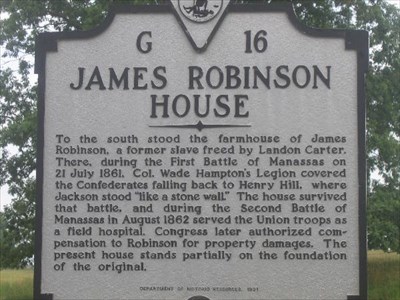|
 James Robinson House Posted by:  pixieslayer pixieslayer
N 38° 49.176 W 077° 31.313
18S E 281057 N 4299779
This is one of 4 historical markers on a gravel pull off of 29 eastbound. Placed in 1991, it gives a brief history of the Robinson House, and how it was used in the battles of Manassas.
Waymark Code: WMK0Q
Location: Virginia, United States
Date Posted: 08/02/2006
Views: 84

G-16: James Robinson House
To the south stood the farm house of James Robinson, a former slave freed by Landon Carter. There, during the First Battle of Manassas on 21 July 1861, Col. Wade Hampton's Legion covered the Confederates falling back to Henry Hill, where Jackson stood "like a stonewall." The house survived that battle and during the Second Battle of Manassas in August 1862 served the Union troops as a field hospital. Congress later authorized compensation to Robinson for property damages. The present house stands partially on the foundation of the original.
James Robinson and his family were one of a few a prominent African American families in the South prior to the Civil War. He and his family continued to live here after the war was over. However, during the use of their house as a field hospital, Robinson felt it was necessary to send his family to hide in the cellar of a near by house. Their family tradition holds that after seeing that his family was safe, Robinson retrieved a few valuables, and took shelter under the turnpike bridge at Young's Branch.
Unfortunately, arsonists destroyed the Robinson House in 1993, and all that remains of that house is the partial foundation. Although there are not many artifacts that survive from James Robinson, his descendents collaborated with staff at Manassas Battlefield Park to tell the story of the Robinson family. Since their story was passed down by oral tradition, the staff could not include some parts because there was no way to verify them.
Landon Carter, the white man who freed James Robinson, was also the owner of the Pittsylvania Plantation, one of 4 thriving Ante Bellum era plantations in Manassas. A brochure developed by the Mountain View Alternative High School claims that Landon Carter fathered James Robinson, but the staff at Manassas Battlefield Park are still researching the validity of this claim.
Robinson was known as "Gentleman Jim". He learned to read and write with Landon Carter's daughters, and later took the surname of their tutor. He later fell in love with Susan Gaskins, a slave from a neighboring farm. They could not marry then, because a free person could not marry a slave. They had six children, who all took the mother's status as a slave.
Although the family was later seperated, after the death of Susan's owner, John Lee, she was freed, along with her daughters Jenny and Jemima. Robinson worked hard, and was able to buy back two of his sons, Tasco and Bladen. Their other two sons, Alfred and James, were sent to the Deep South. After the war was over, Alfred made his way back home, but James was never reunited with his family.
After the Battle of Second Manassas, Robinson temporarily buried 13 soldiers in his front yard, and helped to bury more than 500 soldiers. After being used as a field hospital for the Union soldiers, damages for Robinson's house were estimated at $2,080, but Congress only compensated him for $1,249 by a private act on March 3, 1873.
Gentleman Jim Robinson is also remembered for his work helping newly freed slaves make the adjustments necessary to being a free man during the Reconstruction Era.
Marker Number: G-16

Marker Title: James Robinson House

Marker Location: US 29 Eastbound, east of 234

County or Independent City: Fairfax County/Prince William County Line

Web Site: [Web Link]

Marker Program Sponsor: Department of Historic Resources 1991

|
|